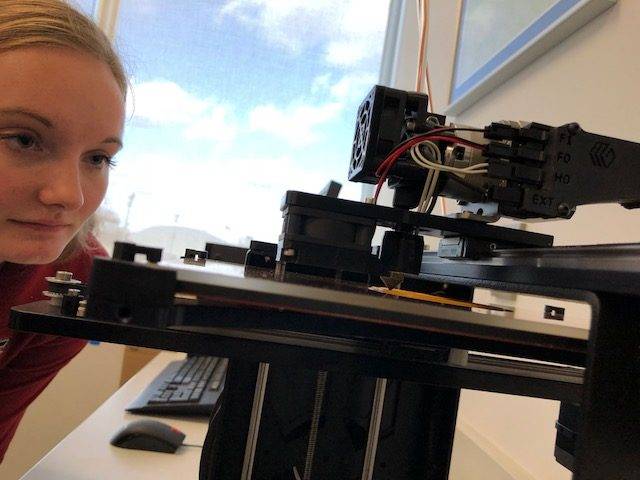[ihc-hide-content ihc_mb_type=”show” ihc_mb_who=”reg” ihc_mb_template=”3″ ]
[vc_row][vc_column][vc_column_text]Dr. Erin Peterson, Assistant Professor of Occupational Therapy, is currently in charge of determining the best use cases of 3D technology to improve occupational therapy education for both master’s and doctoral students. In the summer of 2017, Peterson recommended the school purchase a MakerGear M3 desktop 3D printer, which has a reputation as a workhorse machine, as well as a structured light 3D scanner.
“We wanted something that isn’t noisy, because it’s used in a classroom and prints can sometimes take a few hours to complete,” Peterson said. “We also were looking for the newest technology and good user reviews.”
[/vc_column_text][/vc_column][/vc_row][vc_row][vc_column width=”2/3″][vc_column_text]A partnership with the School of Engineering formed soon after they received the 3D printer. The collaboration has helped Peterson show the value of the technology in the occupational therapy community. Together, they’re working to create innovative designs for assistive devices and custom anatomical models. With their 3D scanner, a therapist or technician has the ability to capture detailed data of a foot, arm, or other body part – and with advanced software, they can turn it into a digital model that’s ready to be 3D printed.
Although the technology offers potential benefits for patients, Peterson says there are some concerns in the occupational therapy community. Many therapists are worried that custom splints or technology assisted devices could take away from some of their work with patients.[/vc_column_text][/vc_column][vc_column width=”1/3″][vc_single_image image=”2510″ img_size=”full” add_caption=”yes”][/vc_column][/vc_row][vc_row][vc_column][vc_column_text]In order to better understand the state of 3D technology in the occupational therapy community, members of the American Society of Hand Therapists provided 300 survey responses to an occupational therapy student research group. The survey will be used to study the perceptions about using 3D technology in the practice of occupational therapy. The findings will be presented at the American Occupational Therapy Association’s Annual Conference in Salt Lake City, Utah in April 2018.
Peterson pointed out that besides custom orthoses and assistive devices, there are other valuable uses for 3D technology. She referenced one study that talks about how 3D printed pill boxes could improve daily medication routines since they can be customized to the specific needs of the patient (adequate size, security, slots per day, etc.); this use of 3D printing has been explored to help in compliance and patient ease.
Peterson is currently working on adding an elective for 3D printing in occupational therapy to their curriculum. She’s also actively developing relationships with faculty from other occupational therapy schools to understand how 3D technology is changing the future of occupational therapy education and practice.[/vc_column_text][/vc_column][/vc_row]
[/ihc-hide-content]
The AM Chronicle Editorial Team is a collective of passionate individuals committed to delivering insightful, accurate and engaging stories to additive manufacturing audiences worldwide.



